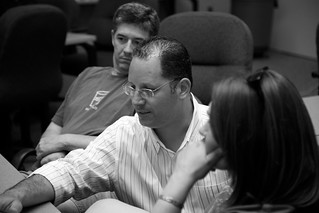The Character of Test Questions
10/05/2011 12:54:00 am Image by rwillia532 via Flickr
Image by rwillia532 via FlickrIn my math classes a typical test is modeled on the character of test questions students will see on their final exams: multiple choice, short answer and long answer.
In a grade 10 math class, what we used to call Applied Math 20S, a multiple choice question might be:
A factory makes tents. The cost of running the factory is $300 per day plus $50 for each tent made. What is the total cost (C), in dollars, as a function of the number of tents (t) made?
(A) C = 350t (B) C = 50t + 300 (C) C = 300t + 50 (D) t = 300 + 50C
I like this question because it quickly allows a student to show whether or not they understand what a "function" is and it's easy to grade. While they have a 25% chance of getting it correct by guessing, in the context of the entire test, and their classroom experiences with me (read: conversations), I know if a student has grasped the concept.
The monthly cost, C, in dollars, of using a cell phone is calculated using the function C(t) = 0.09t + 20 where t is the time in minutes. What is the monthly fee and the cost per minute for this cell phone contract?
Another quickie that reveals whether or not the student can decode the information given in a function. Another question might ask them to reverse that; encode a function given the description of a linear relationship. As a matter of fact, there's a fundamental principle there about learning math: Anything you can do you should also be able to undo. i.e. If you can decode the information in a function you should also be able to encode information in a function.
Here's a long answer question:
The cost of a school graduation dance has a fixed cost of $1500 for the band, security, and so on, and a cost of $22 per plate for every person attending.
(a) Write the formula which states how the total cost, C, is related to the number of people attending, n.
(b) What is the slope? What does it mean?
(c) If the maximum capacity of the hall is 225 people, what is the maximum cost of the dance?
(d) State the domain of this function.
(e) State the range of this function.
The question is not ideal; (d) should be a "gimme" if they understood (c) and (e) depends on the formula they created in (a). Mind you, if they wrote an incorrect formula in (a) but correctly applied it in (e) that's worth full marks in (e).
 |
| Image by nebbsen via Flickr |
Something these three questions have in common is they require that a student understand the meaning of the marks they're making on the page. While every test has some straight forward calculations, by and large calculations are what computers do best. I want my students to understand what the math means and how it hangs together. Computers don't do that so well; although they're getting better at faking it. That's largely because of the cleverness of people who understand the math behind what computers do.
If your assessments largely test mechanical skills that's what your students will focus on learning. If your assessments test for understanding that's what your students will focus on learning. Which would you rather learn?
You don't have to teach math for any of the above to be true, do you?





0 comments